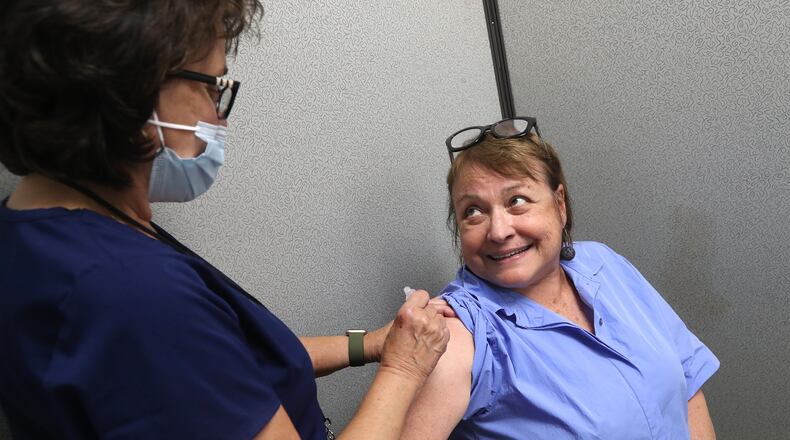COVID-19 cases are gradually climbing, both statewide and locally, leading health officials to remind Ohioans of precautions that can keep them safer from the virus.
Last week, Ohio recorded 18,838 COVID-19 cases, according to the Ohio Department of Health. That’s slightly higher than the average of 17,407 over the past three weeks, and six times higher than the 3,103 in a week that was reported three months ago.
Those statewide numbers and the similar statistics seen on local levels are what led Wright Patterson Air Force Base earlier this week to return the installation to more stringent health protection condition “Bravo.” Mask-wearing remains optional, and a public health emergency was not declared, but there will be mandatory weekly “screening” for employees who have not received COVID-19 vaccinations.
On a statewide level, COVID-19 hospitalizations and ICU admissions dropped from June 30, but are still up from the spring. ODH recorded 411 COVID hospitalizations and 29 ICU admissions in the past week.
As of Thursday, Ohio had 858 people hospitalized with the virus, including 79 in west central Ohio and 112 in southwest Ohio, according to the Ohio Hospital Association.
In west central Ohio, which includes Champaign, Clark, Darke, Greene, Miami, Montgomery, Preble and Shelby counties, that’s an 8% increase from last week and a 295% increase compared to 60 days ago.
Southwest Ohio, which consists of Butler, Warren, Hamilton, Adams, Brown, Clermont and Clinton counties, reported a 7% increase in COVID inpatients in the last week and a 100% increase in the past 60 days, according to OHA.
Also listed at “medium” on the CDC Community Levels index are Greene and Warren counties. Remaining on the “low” part of those levels are Butler, Clark and Miami counties.
Cases in Clark County numbered 138 in April, 575 in May and 684 in June, according to the Clark County Combined Health District.
“As travel has picked up, graduations, things like that, we have seen more community spread, but our hospitals haven’t been as pressed,” said Nate Smith, communications coordinator for the health district. “We haven’t quite seen the hospitalizations we saw like, say, with the Omicron variant.”
COVID numbers haven’t been going up or down in Clark County for five consecutive weeks, with more than 100 cases being reported each week, according to Charles Patterson, the district’s health commissioner.
“These numbers are most likely underreported due to the fact that so many people are using home test kits and many of those positive results do not get reported to the local health departments,” Patterson said.
In terms of what the health district advises the public should do, “there really are no changes,” he said.
“Continue to have as many events outdoors as possible and just realize that we continue to have this uptick in cases from Omicron, most likely from BA.4 and BA.5 now, which are the predominant strains, and they are affecting people basically whether they’re vaccinated or not,” Patterson said. “The vaccines continue to prevent hospitalizations and very intense cases, but the vaccination doesn’t appear to stop the actual spread from person to person of the Omicron variant.”
Smith said those who are traveling from a place where community spread is lower, like Clark County, to a place where it is more rapidly spreading, run a greater risk and should consider taking precautions.
“Maybe you’re not worried too much about wearing a mask if you’re going the same places all the time in your hometown, but if you’re traveling, it certainly may be a good idea to put one on,” he said.
Butler County, like many other parts of southwest Ohio, has continued to see a “slow but steady” rise in COVID-19 cases over the last month or so, according to Erik Balster, health commissioner for the Butler County General Health District.
Balster said the health department recommends residents stay up to date on vaccines and consult with their primary care physician for any questions about the timing of such measures. He said the health department is encouraging personal responsibility as a way of minimizing COVID cases.
“If you’re feeling ill or sick, there’s more than enough tests to go around, free of course through us and other health departments,” he said. “If you’re not feeling good, you can eliminate some of these increasing (COVID) numbers by just staying home, much like you could with flu or any other illness.”
There were 120 coronavirus patients in Ohio’s ICUs Thursday, including 16 in southwest Ohio and 10 in west central Ohio. That’s a 67% increase compared to last week and 900% increase compared to 60 days ago for west central Ohio, according to OHA.
More than 63% of Ohioans have started the COVID-19 vaccine and 58.5% have finished it, according to ODH.

